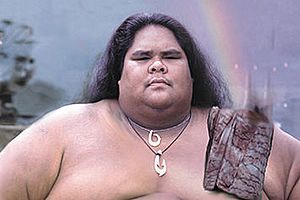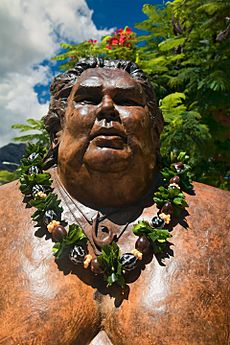Israel Kamakawiwoʻole facts for kids
Quick facts for kids
Israel Kamakawiwoʻole
|
|
|---|---|

Kamakawiwoʻole in 1993
|
|
| Born |
Israel Kaʻanoʻi Kamakawiwoʻole
May 20, 1959 |
| Died | June 26, 1997 (aged 38) Honolulu, Hawaii, U.S.
|
| Occupation |
|
| Years active | 1976–1997 |
| Children | 1 |
| Musical career | |
| Genres | |
| Instruments |
|
| Labels | Mountain Apple Company |
| Associated acts | Mākaha Sons of Niʻihau |
Israel Kaʻanoʻi Kamakawiwoʻole (pronounced "kah-mah-kah-VEE-voh-OH-lay"), also known as Bruddah Iz or just IZ, was a famous Hawaiian musician. His name means 'the fearless eye' or 'the bold face'. He was a talented singer, songwriter, and also an activist for Hawaiian independence.
He became very popular outside of Hawaii when his album Facing Future came out in 1993. His special mix of "Somewhere Over the Rainbow/What a Wonderful World" became a huge hit. This song was used in many movies, TV shows, and commercials. It stayed at the top of the World Digital Songs chart for 358 weeks. This makes it the longest-running number-one song on any Billboard chart ever!
Israel Kamakawiwoʻole played the ukulele and mixed different music styles like jazz and reggae. He is still very important in Hawaiian music. Many people think he is the greatest Hawaiian musician of all time. In 2010, NPR called him "The Voice of Hawai‘i".
Contents
Early Life and Musical Beginnings
Israel Kamakawiwoʻole was born in Honolulu, Hawaii. His parents worked at a popular nightclub in Waikiki. His uncle, Moe Keale, was also a musician and a big influence on him. Israel grew up in Kaimuki.
He started playing music at age 11 with his older brother Henry ("Skippy") and his cousin Allen. They listened to many Hawaiian musicians like Peter Moon and Don Ho. One musician, Del Beazley, remembered how everyone went silent when they first heard Israel sing.
When he was a teenager, his family moved to Mākaha. There, he met Louis Kauakahi, Sam Gray, and Jerome Koko. With his brother Skippy, they formed a band called the Makaha Sons of Niʻihau. This band became part of the Hawaiian Renaissance. They mixed old and new Hawaiian music styles. The band became very popular, touring Hawaii and the United States. Israel wanted to keep their music true to traditional Hawaiian sounds.
Music Career and Famous Songs
The Makaha Sons of Niʻihau released their first album, No Kristo, in 1976. They made many successful albums, becoming Hawaii's most popular traditional group. Their albums Puana Hou Me Ke Aloha (1984) and Hoʻola (1986) were very popular. Israel's last album with the group was Hoʻoluana in 1991, which is still their best-selling CD.
In 1982, his brother Skippy passed away at 28. Later that year, Israel married his childhood sweetheart, Marlene. They had a daughter named Ceslie-Ann "Wehi" around 1983.
In 1990, Israel released his first solo album called Ka ʻAnoʻi. It won awards for Contemporary Album of the Year and Male Vocalist of the Year from the Hawaiʻi Academy of Recording Arts (HARA).
His album Facing Future came out in 1993. This album included his most famous song, the mix of "Somewhere Over the Rainbow/What a Wonderful World". It also had other popular songs like "Hawaiʻi '78" and "White Sandy Beach". Facing Future became Hawaii's first platinum album, selling over a million copies in the United States.
In 1994, Israel was named favorite entertainer of the year by HARA. His albums E Ala E (1995) and N Dis Life (1996) also featured popular songs. In 1997, he won more awards from HARA, including Male Vocalist of the Year and Album of the Year. He watched the awards from his hospital room.
After he passed away, the album Alone in Iz World (2001) was released. It quickly became number one on Billboard's World Chart. His album Facing Future is the best-selling album by a Hawaiian artist ever.
Supporting Hawaiian Rights
Israel Kamakawiwoʻole was well-known for supporting Hawaiian rights and independence. He did this through his songs and his actions. For example, in his song "Hawaiʻi '78," he sang, "The life of this land is the life of the people." This line shows his strong belief that caring for the land means caring for Hawaiian culture.
He often used the state motto of Hawaiʻi in his songs: "Ua Mau ke Ea o ka ʻĀina i ka Pono." This means "The life of the land is perpetuated in righteousness." This motto was first spoken by King Kamehameha III when Hawaii became independent in 1843. Israel used his music to show that native Hawaiians should not be treated as second-class citizens because of the tourism industry.
Later Life and Passing
In the 1990s, Israel became a Christian. He was baptized in 1996 and often spoke about his faith. He even recorded a song called "Ke Alo O Iesu" (The Presence of Jesus).
Israel had serious health problems throughout his life due to his weight. He was in the hospital many times. He passed away at age 38 on June 26, 1997, due to breathing and heart issues.
On July 10, 1997, the Hawaiian flag flew at half-staff for his funeral. His special koa wood casket was placed at the state capitol building in Honolulu. He was only the third person, and the only non-government official, to receive this honor. About 10,000 people came to his funeral. Thousands more gathered as his ashes were scattered into the Pacific Ocean at Mākua Beach on July 12, 1997. Many people honked their car horns on Hawaiian highways to remember him. Videos of his funeral and the scattering of his ashes were used in the official music videos for "Over the Rainbow." As of November 2022, these videos have been watched over 1.259 billion times on YouTube.

On September 20, 2003, a bronze statue of Israel was revealed at the Waianae Neighborhood Community Center on Oʻahu. His wife, Marlene, and the sculptor were there for the ceremony.
Israel Kamakawiwoʻole's Legacy
On December 6, 2010, NPR called Israel Kamakawiwoʻole "The Voice of Hawaii." This was part of their "50 great voices" series.
On March 24, 2011, he was honored with the German national music award Echo.
A 2014 Pixar short film called Lava was partly inspired by Israel's cover of "Somewhere Over the Rainbow" and his musical style.
On May 20, 2020, Google Doodle celebrated Israel's 61st birthday. They featured information about his life, music, and impact on Hawaii. They also made a two-minute cartoon video with his "Somewhere Over the Rainbow" song playing. The video showed places in Hawaii that were special to him, like Diamond Head and Mākaha Beach.
The Story of "Somewhere Over the Rainbow/What a Wonderful World"
Israel Kamakawiwoʻole's recording of "Somewhere Over the Rainbow/What a Wonderful World" became very popular in 1999. It was used in TV commercials for eToys.com. The full song was later featured in many movies like Meet Joe Black, Finding Forrester, 50 First Dates, and Fred Claus. It also appeared in TV shows such as ER, Scrubs, Glee, and Modern Family.
In 1988, a friend called a recording studio in Honolulu at 3:00 am. He asked if Israel could come in to record. The studio owner, Milan Bertosa, agreed if Israel could get there in 15 minutes. Bertosa remembered Israel was very large, so a security guard found a big steel chair for him. Bertosa said, "I put up some microphones, do a quick sound check, roll tape, and the first thing he does is 'Somewhere Over the Rainbow.' He played and sang, one take, and it was over."
Five years later, Bertosa was working at Mountain Apple Company when Israel was making a solo album. Bertosa remembered the old recording and showed it to Israel's producer, Jon de Mello. The original 1988 acoustic version of the song was then released on the 1993 Facing Future album.
This song became incredibly successful. It reached No. 12 on Billboard's Hot Digital Tracks chart in 2004. By 2014, it had sold over 4.2 million digital copies. It holds the record for the longest time at number one on any Billboard song chart, staying on top of the World Digital Songs chart for 358 weeks.
In 2007, "Wonderful World" debuted at No. 44 on the Billboard Top 200 Album Chart. In April 2007, "Over the Rainbow" also entered the UK charts. In October 2010, it hit No. 1 on the German singles chart and was the best-selling single of 2010 there. It also reached No. 1 in France and Switzerland in late 2010.
In 2021, the song was added to the National Recording Registry. This means it is considered an important part of American recorded sound history.
Discography
Studio albums
- Ka ʻAnoʻi (1990)
- Facing Future (1993)
- E Ala E (1995)
- N Dis Life (1996)
Compilation albums
- IZ in Concert: The Man and His Music (1998)
- Alone in IZ World (2001)
- Wonderful World (2007)
- Somewhere Over the Rainbow: The Best of Israel Kamakawiwoʻole (2011)
See also
 In Spanish: Israel Kamakawiwoʻole para niños
In Spanish: Israel Kamakawiwoʻole para niños

